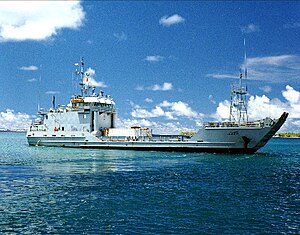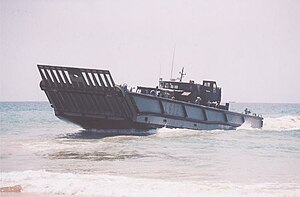Landing Craft Utility

LCU L53 Launch
|
|
| Class overview | |
|---|---|
| Name: | LCU MK IV class |
| Builders: | GRSE |
| Operators: |
|
| Preceded by: | LCU Mk III |
| Built: | 2011– |
| Building: | 2 |
| Planned: | 8 |
| Completed: | 6 |
| Active: | 0 |
| General characteristics | |
| Displacement: | 1001 tons |
| Length: | 62.8m |
| Draught: | 1.7m |
| Depth: | 4m |
| Propulsion: | 2 x MTU 16V 4000 M53 marine diesel engines (1,840 kW) with a twin fixed-pitch propeller propulsion system |
| Speed: | 15 kt |
| Range: | 1,500nm at 12 kt |
| Troops: | 160 |
| Complement: | 216 |
| Crew: | 56 |
| Sensors and processing systems: |
|
| Armament: |
|
 |
|
| Class overview | |
|---|---|
| Name: | LCU Mk.II (NL) class |
| Operators: |
|
| General characteristics | |
| Type: | Ro-Ro landing craft |
| Displacement: | 255 tonnes (251 long tons) |
| Length: | 36.3 m (119 ft 1 in) |
| Beam: | 6.85 m (22 ft 6 in) |
| Draft: |
|
| Capacity: | 65 tonnes (64 long tons) |
| Complement: | 7 |
| Armament: | 2 × Browning .50 calibre (12.7 mm) machine guns |

LCU Mk.9 (now retired)
|
|
| Class overview | |
|---|---|
| Name: | Landing Craft Utility |
| Operators: |
|
| Subclasses: | LCU Mk.9 and LCU Mk.10 |
| Active: | 10 LCU Mk.10s |
| Retired: | LCU Mk.9s |
| General characteristics LCU Mk.10 | |
| Displacement: | 240 t (240 long tons; 260 short tons) |
| Length: | 97 ft 10 in (29.82 m) |
| Beam: | 25 ft 3 in (7.70 m) |
| Draught: | 4 ft 11 in (1.50 m) |
| Propulsion: | 2 × MAN D2840 LE diesel engines (400 kW / 2150 r.p.m. each) |
| Speed: | 10 knots (19 km/h; 12 mph) |
| Range: | 600 nautical miles (1,100 km) |
| Capacity: | 1 main battle tank, 4 large vehicles, or 120 troops |

LCU-1627
|
|
| Class overview | |
|---|---|
| Name: | LCU 1466, 1610 and 1627 classes |
| Operators: |
|
| Active: | 32 |
| General characteristics | |
| Displacement: | see table |
| Length: | see table |
| Beam: | see table |
| Draft: | see table |
| Propulsion: | see table |
| Speed: | see table |
| Range: | see table |
| Endurance: | 10 days |
| Capacity: | see table |
| Troops: | see table |
| Sensors and processing systems: |
LN 66 or SPS-53 I band navigation radar |
| Armament: | 2 × 12.7 mm machine guns |
 |
|
| Class overview | |
|---|---|
| Name: | LCU 2000 class |
| Operators: |
|
| General characteristics | |
| Displacement: |
|
| Length: | 174 ft (53 m) |
| Beam: | 42 ft (13 m) |
| Draft: |
|
| Speed: | 11.5 knots (21.3 km/h; 13.2 mph) |
| Range: | |
| Capacity: |
|
| Complement: | 13 |
 |
|
| Class overview | |
|---|---|
| Name: | Dyugon-class landing craft |
| Operators: |
|
| General characteristics | |
| Displacement: |
|
| Length: | 169 ft (52 m) |
| Beam: | 36 ft (11 m) |
| Draft: |
|
| Speed: | 35 knots (65 km/h; 40 mph) |
| Range: | |
| Capacity: |
|
| Complement: | 7 |
| Armament: | 2 KPV 14.5 mm machine guns |

L-602
|
|
| Class overview | |
|---|---|
| Name: | LCM-1E |
| Builders: | Navantia |
| Operators: | |
| Preceded by: | LCM-8 |
| Planned: | 30 |
| Completed: | 26 |
| Active: | 24 |
| Retired: | 2 |
| General characteristics | |
| Type: | Roll-on/roll-off landing craft mechanised |
| Displacement: |
|
| Length: | 23.3 metres (76 ft) |
| Beam: | 6.4 metres (21 ft) |
| Draught: | 1 metre (3 ft 3 in) loaded |
| Ramps: | Bow ramp and stern gate |
| Propulsion: |
|
| Speed: |
|
| Range: | 190 nautical miles (350 km; 220 mi) at economic speed |
| Capacity: |
|
| Complement: | 4 |
The Landing Craft Utility (LCU) is a type of boat used by amphibious forces to transport equipment and troops to the shore. They are capable of transporting tracked or wheeled vehicles and troops from amphibious assault ships to beachheads or piers.
The Engin de débarquement amphibie rapide (EDA-R) landing catamaran or L-CAT, entered service in January 2011. They can carry a main battle tank like other European LCUs but are capable of much higher speeds, up to 30 knots (56 km/h; 35 mph).
Germany has two Barbe-class utility landing craft (Type 520), dating from the mid-1960s, which remain in service under the SEK-M Naval Special Forces' command. Germany is looking to acquire more such crafts. Five Barbe landing crafts were transferred to Greece at the end of the Cold War.
India currently has six LCUs of the Mk III class and four LCUs of the Mk IV class.
The first Mk III class LCU was commissioned on 18 July 1986.
With the launch of the amphibious transport ship HNLMS Rotterdam in 1998 there was a need for LCUs. The Dutch LCUs are similar to the British LCU Mk.10 with the bridge being set to one side allowing for a roll-on roll-off design. Until 2005 the Netherlands Marine Corps used the LCU Mark I (NL).
In 2005 and 2006 the five vessels were modernized to the type Mark II. The vessels have been stretched by 9 meters to decrease their draft, which increased their load carrying capacity by 20 tons and allows them to come closer to shore. In addition they were fitted with a strengthened bow ramp, and they can now accommodate the Royal Netherlands Army Leopard 2 A6 main battle tank. Because of the lengthening of the Mark II, the Rotterdam can take two LCUs (plus three LCVPs) in its dock. The dock of Rotterdam's sister ship, HNLMS Johan de Witt, has the capacity to transport two LCUs, but carries four LCVPs in davits.
...
Wikipedia
